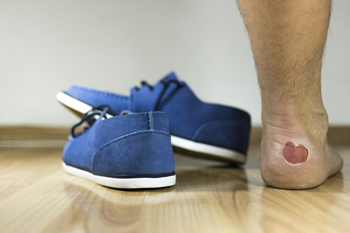
Blisters on the feet can develop due to various causes, leading to discomfort and difficulty in walking. Friction from wearing tight or ill-fitting shoes creates repeated rubbing against the skin, resulting in fluid-filled pockets. Excessive heat, such as walking on hot surfaces or prolonged sun exposure, can cause burns that form blisters. Additionally, exposure to extreme cold may lead to frostbite, damaging the skin and leading to blister formation. Chemical irritation from harsh substances or allergic reactions to medications can also contribute to blister development. There are different types of blisters, including those that are clear fluid-filled caused by friction or burns, blood blisters resulting from deeper tissue damage, and infected blisters that appear red, swollen, and filled with pus. Foot blisters can be painful, and may cause difficulty in completing daily activities. If you have a blister on your foot that has become painful, it is suggested that you promptly consult a podiatrist who can offer safe treatment and prevention solutions.
Blisters are prone to making everyday activities extremely uncomfortable. If your feet are hurting, contact Afshin Javaherian, DPM of Dr. Java Foot & Ankle Clinic. Our doctor can provide the care you need to keep you pain-free and on your feet.
Foot Blisters
Foot blisters develop as a result of constantly wearing tight or ill-fitting footwear. This happens due to the constant rubbing from the shoe, which can often lead to pain.
What Are Foot Blisters?
A foot blister is a small fluid-filled pocket that forms on the upper-most layer of the skin. Blisters are filled with clear fluid and can lead to blood drainage or pus if the area becomes infected.
How Do Blisters Form?
Blisters on the feet are often the result of constant friction of skin and material, usually by shoe rubbing. Walking in sandals, boots, or shoes that don’t fit properly for long periods of time can result in a blister. Having consistent foot moisture and humidity can easily lead to blister formation.
Prevention & Treatment
It is important to properly care for the affected area in order to prevent infection and ease the pain. Do not lance the blister and use a Band-Aid to provide pain relief. Also, be sure to keep your feet dry and wear proper fitting shoes. If you see blood or pus in a blister, seek assistance from a podiatrist.
If you have any questions, please feel free to contact our office located in Los Angeles, CA . We offer the newest diagnostic and treatment technologies for all your foot care needs.

